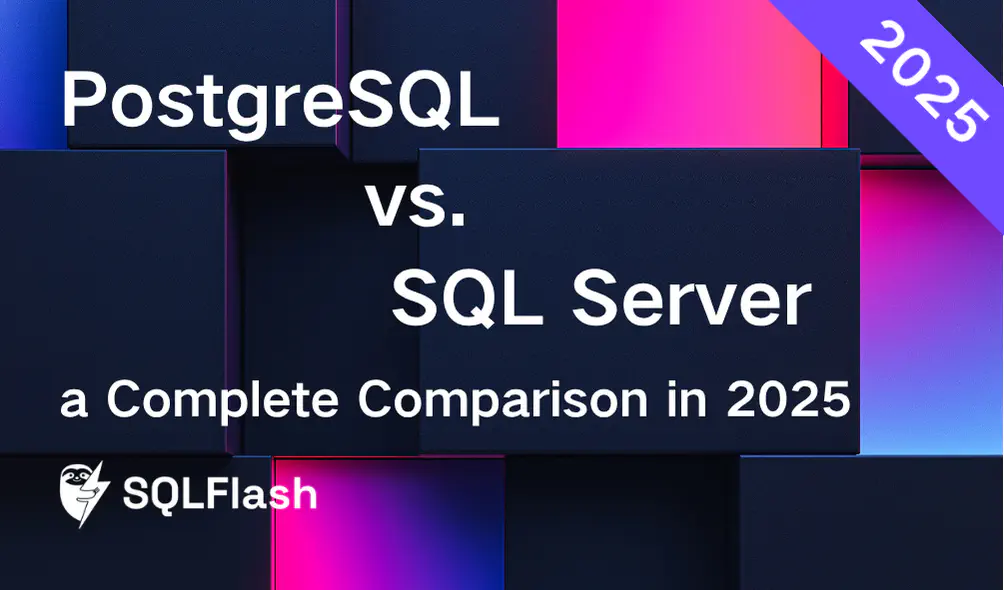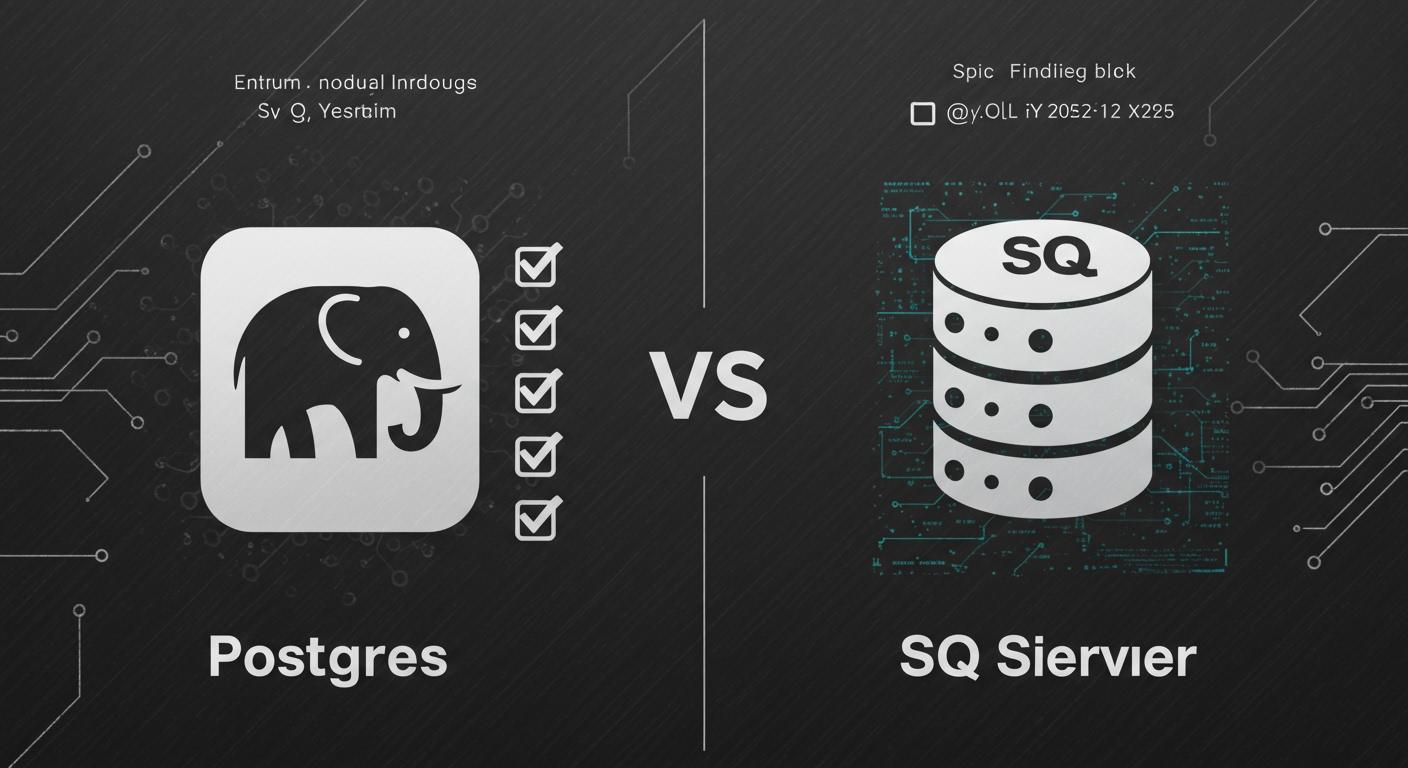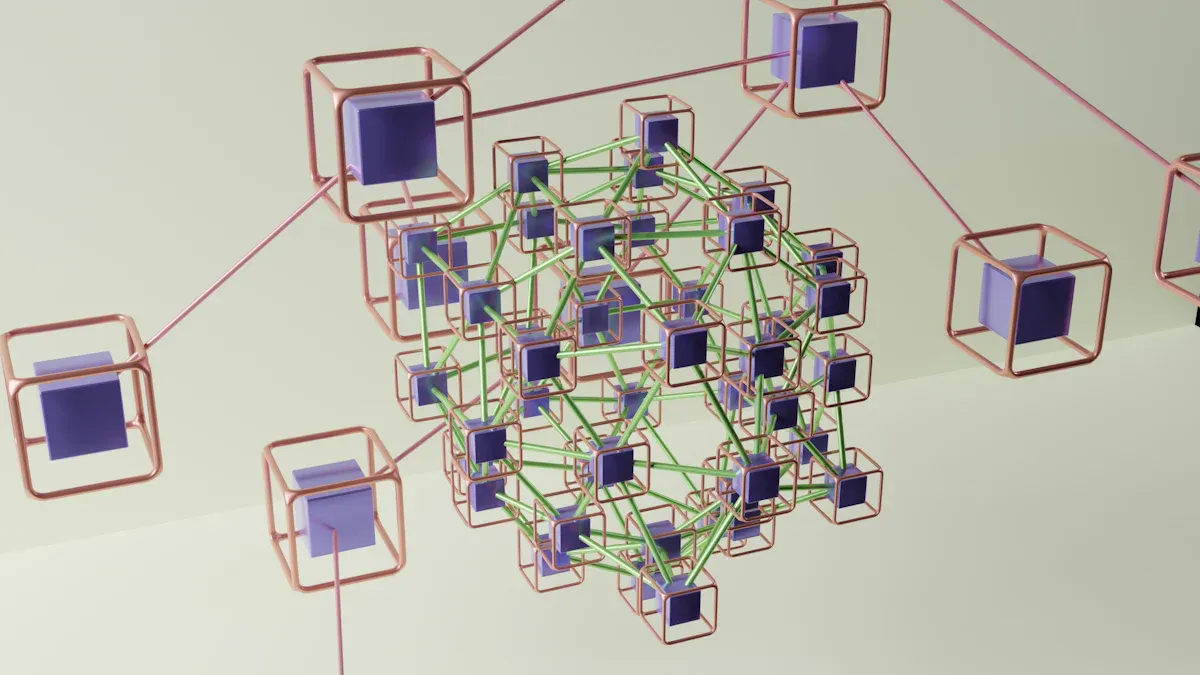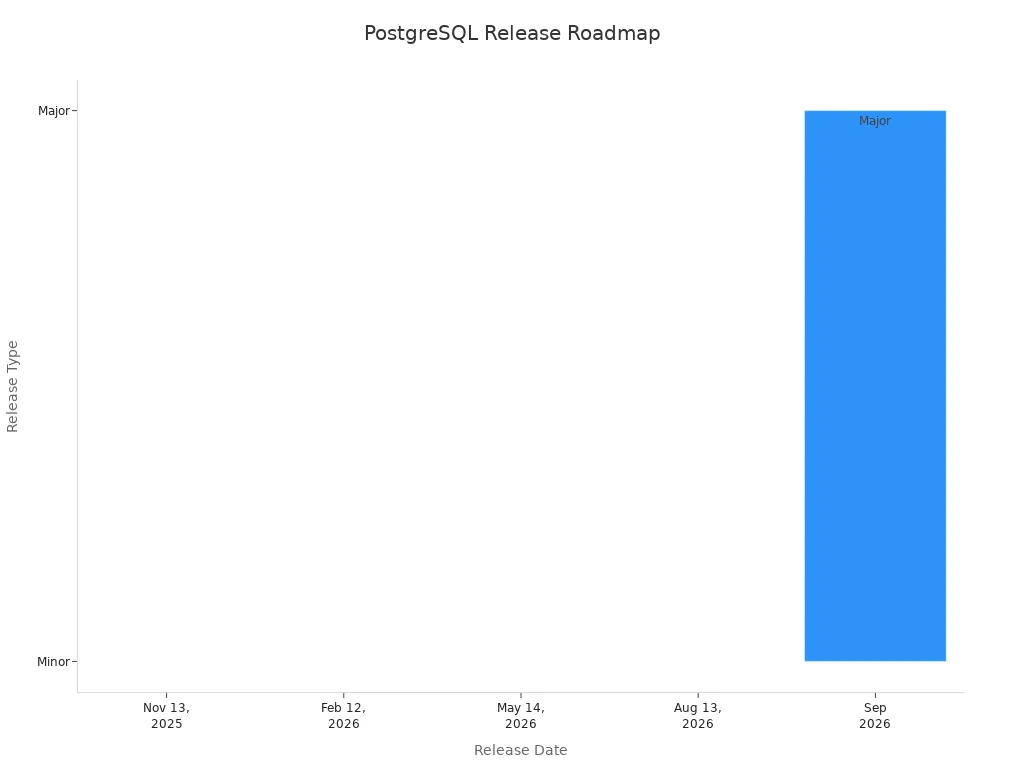Postgres vs. SQL Server: a Complete Comparison in 2025



Explore the differences between PostgreSQL 18 and SQL Server.
| Features | PostgreSQL 18 | SQL Server |
|---|---|---|
| Licensing | Open source, no licensing fees. | Commercial, requires licensing fees. |
| Performance | New I/O system enhances speed. | AI tools improve analytics performance. |
| Extensibility | Supports custom extensions and languages. | Primarily uses T-SQL for changes. |
| Integration | Works well with various cloud services. | Best with Microsoft products and Azure. |
| Security | OAuth 2.0 and SSL support. | TDE and Always Encrypted features. |
| Community Support | Strong open-source community backing. | Large enterprise user base with Microsoft support. |
| Data Types | More built-in types like arrays. | Limited to standard types, no arrays. |
| Usability | Complex features, steeper learning curve. | User-friendly GUI for easier navigation. |
In 2025, you have a clear choice between PostgreSQL and SQLServer. PostgreSQL 18 is ideal for organizations seeking an open-source solution with impressive speed. SQLServer is a strong option for those who prefer integration with Azure tools. PostgreSQL 18 leads in popularity, with 58% of users, while SQLServer holds 30%. The latest PostgreSQL 18 release introduces asynchronous I/O, enhanced index utilization, OAuth authentication, and virtual columns. On the other hand, SQLServer brings new AI tools, NUMA support, and AVX-512 enhancements. Comparing PostgreSQL and SQLServer is essential, as both platforms continue to transform the way you manage and optimize data.
If you need a database that does the basics well, both PostgreSQL 18 and SQL Server are good choices. They both follow SQL standards and keep your data safe with ACID compliance. You can make tables, ask questions with queries, and use indexes in both. Each one lets you use stored procedures and triggers. PostgreSQL 18 is open-source, so you do not pay for a license. SQL Server works well with Microsoft tools, which helps if you use Windows or Azure.
| Feature | PostgreSQL 18 | SQL Server |
|---|---|---|
| SQL Compliance | High | High |
| ACID Transactions | Yes | Yes |
| Stored Procedures | Yes | Yes |
| Triggers | Yes | Yes |
| Licensing | Open Source | Commercial |
If you need more power, advanced features help with tough jobs. PostgreSQL 18 has a new I/O system. This makes data faster and helps with big sets of data. SQL Server uses AI analytics and works better with hardware like NUMA and AVX-512. Both can split data, copy it, and use smart indexing. PostgreSQL 18 also makes upgrades simple, so you spend less time fixing things.
PostgreSQL 18: New I/O system, easy upgrades, smart indexing
SQL Server: AI analytics, NUMA/AVX-512 support, smart partitioning
Some features make each database special. PostgreSQL 18 now has virtual columns. These let you figure out values quickly, which helps with reports and analytics. The new OAuth 2.0 support lets PostgreSQL 18 work with new login systems. SQL Server connects with Power BI and Azure Synapse. If you want to see what makes PostgreSQL and SQL Server different, check how they fit your work and security needs.
Tip: When you look at PostgreSQL and SQL Server, pick the features that help your project. Special things like virtual columns or AI analytics can really help.
When you look at how fast PostgreSQL and SQL Server work, both can handle lots of data. PostgreSQL 18 has a new I/O system. This helps you get data faster. Using indexes makes reading data even quicker. Your apps can answer fast, even with many users.
PostgreSQL 18 uses better locking. This means less waiting when many people use it.
Multi-Version Concurrency Control (MVCC) in PostgreSQL lets you read and write at the same time. You do not have to wait for others to finish. This is good for busy systems.
SQL Server uses special hardware features like NUMA and AVX-512. These help with big data jobs and analytics. SQL Server also has AI tools for quick answers.
If you have lots of users or need fast reports, both are strong. PostgreSQL 18 is great when many people use it at once. SQL Server is best if you use special hardware or want AI features.
You want your database to grow as you need more. PostgreSQL and SQL Server let you add new things, but in different ways. PostgreSQL 18 lets you add more tools and languages.
| Feature | PostgreSQL 18 | SQL Server |
|---|---|---|
| Extensibility | You can add custom extensions, languages, and data types. | You mostly use T-SQL for changes. |
| Procedural Language Support | You can use many languages like PL/pgSQL, PL/Python, and PL/Perl. | You mainly use T-SQL. |
| Community and Development | Open-source means many people help make it better. | It works well with Microsoft tools but has a smaller community. |
With PostgreSQL 18, you can use different programming languages. You can also add your own features. SQL Server works best with T-SQL and Microsoft tools. If you want to build new things or use many languages, PostgreSQL 18 gives you more choices.
It is important to connect your database to other tools. PostgreSQL and SQL Server both let you do this, but they focus on different things.
PostgreSQL 18 works with OAuth 2.0. This makes logging in safe and easy.
You can use PostgreSQL with many clouds, languages, and plugins. The open-source group makes lots of connectors.
SQL Server works best with Microsoft products. You can use it with Azure, Power BI, and other Microsoft tools. This is good if you use Microsoft a lot.
Note: Pick the database that matches your work. If you use open-source tools or want more ways to connect, PostgreSQL 18 is a good pick. If you use Microsoft tools, SQL Server may be better.
You might wonder how PostgreSQL 18 and SQL Server work inside. Their main designs decide how they handle connections, memory, and keeping data safe. PostgreSQL 18 uses a process-based setup. Each client gets its own server process. If one process crashes, others keep working fine. This helps make things stable. SQL Server uses threads instead. It has a thread pool for many connections. This can use system resources better.
| Feature | PostgreSQL 18 | SQL Server |
|---|---|---|
| Architecture Type | Process-based | Thread-based |
| Client Connection | New process per connection | Thread pool |
| Memory Management | Shared memory for caching and IPC | SQLOS layer |
| Durability Mechanism | Write-Ahead Logging (WAL) | Transaction log |
| Concurrency Control | Multi-Version Concurrency Control | Lock manager |
| Extensibility | Hooks for extensions | Not specified |
| Metadata Management | Catalog-driven | Not specified |
Tip: If you want each connection to be separate, PostgreSQL 18 is good. If you want to handle lots of users with less work, SQL Server’s thread pool helps.
You need to find things fast and get reports quickly. Both databases use indexes, but they do it in different ways. PostgreSQL 18 lets you change statistics with the ANALYZE command. You can do this by hand or let autovacuum do it for you. SQL Server updates statistics by itself when lots of data changes. You can also use commands like sp_updatestats.
| Feature | PostgreSQL 18 | SQL Server |
|---|---|---|
| Statistics Maintenance | ANALYZE command | Automatic |
| Automatic Updates | During autovacuum | Data change thresholds |
| Manual Updates | ANALYZE | sp_updatestats and others |
| Flexibility | Highly configurable | Adaptive and self-sufficient |
Note: PostgreSQL 18 lets you control more things. SQL Server does most updates for you.
You want to save all kinds of data. PostgreSQL 18 and SQL Server both let you store numbers, text, and dates. PostgreSQL 18 has more built-in types, like arrays and JSONB. SQL Server works for most needs but does not have arrays built in.
| PostgreSQL Data Type | SQL Server Equivalent | Unique Features |
|---|---|---|
| BOOLEAN | BIT | Dedicated BOOLEAN type in PostgreSQL 18 |
| TEXT | VARCHAR(MAX) | Flexible text storage in PostgreSQL 18 |
| JSON | NVARCHAR | JSON and JSONB types in PostgreSQL 18 for better JSON optimization |
| ARRAY | N/A | Arrays supported in PostgreSQL 18 |
| UUID | UNIQUEIDENTIFIER | More flexible UUID handling in PostgreSQL 18 |
When you look at PostgreSQL and SQL Server, you see PostgreSQL 18 gives you more choices for tricky data.
You want a database that is easy to use. PostgreSQL 18 and SQL Server feel different for users. SQL Server has a nice graphical interface. You can click menus and see your data. This makes it simple to learn. PostgreSQL 18 has strong features like complex queries and full-text search. It also works with geospatial data. These features make PostgreSQL 18 harder to learn at first.
| Feature | PostgreSQL 18 | SQL Server |
|---|---|---|
| Advanced Features | Complex queries, indexing, full-text, geospatial | Robust GUI, seamless Microsoft integration |
| Scalability | Horizontal scaling, cloud integration | Standard: 24 cores, Enterprise: unlimited cores |
| Community Support | Strong open-source community | Large enterprise user base |
| Learning Curve | Steep due to advanced features | Easier with GUI tools |
Tip: SQL Server’s GUI is good for beginners. PostgreSQL 18 gives you more control if you want it.
You need tools to help manage your database. PostgreSQL 18 has pgAdmin for web browser management. Prometheus can watch your database, but you must set it up. DataDog is easy to use and has many features. OpenTelemetry lets you track how your database works. pgBadger helps you find slow queries. PRTG and SolarWinds can watch both PostgreSQL and SQL Server.
pgAdmin: Manage PostgreSQL in your browser.
Prometheus: Watch performance with open-source tools.
DataDog: Easy setup and strong monitoring.
OpenTelemetry: Track what your database does.
pgBadger: Find slow queries in logs.
PRTG: Watch many databases, including SQL Server.
SolarWinds: Check query speed and performance.
You want your database to work with your apps and tools. PostgreSQL 18 and SQL Server fit into modern workflows. You can use Liquibase for safe migrations with rollback. Flyway helps you run scripts with versions. Always test changes on staging data first. PostgreSQL 18 lets you make indexes without stopping the database. Both work with CI/CD pipelines for smooth updates.
Use Liquibase or Flyway for safe migrations.
Test changes before you deploy.
Note: Both PostgreSQL 18 and SQL Server work with DevOps. Pick the one that fits your team’s tools best.
When you pick a database, you must think about the price. PostgreSQL 18 and SQL Server cost very different amounts. PostgreSQL 18 is open source, so you do not pay for a license. SQL Server needs a license, and this can get expensive over time. You should also think about cloud fees, support, and paying workers.
Here is a table that shows what you might pay for each database in 2025:
| TCO Component | PostgreSQL (Community) | Microsoft SQL Server (Enterprise) |
|---|---|---|
| Core License Cost (5-year) | $0 | ~$57,000 (Single 8-core server) |
| Estimated Monthly Cloud Infrastructure | ~$510 - $800+ (AWS, GCP, Azure) | Included in cloud-based pricing |
| Estimated Annual Support Cost | $15,000+ (Vendor-specific) | Included with software assurance or managed service |
| Estimated Annual Labor Cost (DBA) | ~$102,260 - $115,000 | ~$87,400 - $119,317 |
Note: PostgreSQL 18 helps you save money on licenses, but you might still pay for support and cloud use. SQL Server puts some costs in its managed services, but the license is much more.
Licensing changes how you plan your spending. PostgreSQL 18 uses an open-source license. You do not pay for the software, and you can use it as much as you want. This lets you spend less and use your money for new things. You also do not have to worry about hard license rules.
SQL Server uses a commercial license. You pay for each core or user. This can make your costs go up if your company gets bigger. You might also need more database workers, which costs more.
Tip: If you want to keep costs low and not worry about licenses, PostgreSQL 18 gives you more freedom. SQL Server is good if you already use Microsoft tools and want support included.
You want to keep your data safe from people who should not see it. Both PostgreSQL 18 and SQL Server have strong ways to check who can get in, but they do it differently. PostgreSQL 18 lets you pick from scram-sha-256, md5, LDAP, Kerberos, or TLS certificates. You can pick what works best for your setup. SQL Server uses roles to control who can do what. It also has Transparent Data Encryption (TDE) and Always Encrypted to help manage users.
| Database System | Authentication Mechanisms | Security Features |
|---|---|---|
| PostgreSQL 18 | scram-sha-256, md5, LDAP, Kerberos, TLS certificates | Role-based access, SSL for data in transit, cryptogenic functions |
| SQL Server | TDE, Always Encrypted, Windows Authentication | AES encryption, column-level encryption, roles and groups |
Tip: PostgreSQL 18 lets you use SSL certificates for safe logins. SQL Server makes it easy to manage users with roles and groups.
You need to keep your data safe when it is saved and when it moves. PostgreSQL 18 and SQL Server both help, but use different tools.
PostgreSQL 18 saves passwords as hashes, so no one sees your real password. SCRAM is the best way to keep passwords safe.
You can use the pgcrypto module in PostgreSQL 18 to lock certain columns. This keeps private data safe.
PostgreSQL 18 uses SSL to lock all data sent over the network. You can make SSL required for every connection.
SQL Server uses AES to lock files and can lock columns too. TDE and Always Encrypted keep your data safe when stored or used.
Note: Both databases let you use extra encryption on the client side if you want more safety.
Sometimes you must follow rules like GDPR or HIPAA. Both PostgreSQL 18 and SQL Server help you do this. PostgreSQL 18 gives you detailed controls and strong logs. SQL Server has built-in tools for checking and following rules. You can use these to see who looked at your data and when.
PostgreSQL 18: Detailed access control, audit logs, SSL rules.
SQL Server: Built-in checks, reports for rules, locks for private data.
Remember: Always check your industry’s rules and use the right settings to keep your data safe.

Image Source: unsplash
You want your database to grow with your business. PostgreSQL 18 and SQL Server both let you scale up or out. They do this in different ways. PostgreSQL 18 lets you add more memory or CPU to your server. This is called vertical scaling. It is easy, but you can hit hardware limits. If you need more, PostgreSQL 18 uses horizontal scaling. You can split your data across many servers. This is done with sharding and partitioning. It helps you handle more users and more data. But it needs careful planning.
SQL Server also lets you scale up by upgrading your server. For horizontal scaling, it uses distributed partitioned views and sharding. Both databases let you pick the best way to grow for your needs.
You want your database to stay online if something breaks. Both PostgreSQL 18 and SQL Server have strong high availability options. Here are some solutions:
| High Availability Solution | Description |
|---|---|
| Shared Storage Subsystem | Uses shared storage so a standby server can take over if the main one fails. |
| Shared Nothing Architecture | Each server has its own copy of the database, reducing single points of failure. |
| repmgr | Manages high availability in PostgreSQL with streaming replication. |
| pg_auto_failover | Controls primary and standby servers in PostgreSQL for automatic failover. |
SQL Server has Always On Availability Groups and failover clustering. These keep your data safe and your apps working.
Tip: Choose a high availability setup that fits your risk and downtime needs.
You might want to run your database in the cloud. PostgreSQL 18 and SQL Server both work with big cloud providers. Managed services save you time and work.
| Cloud Provider | Managed Service | Key Features |
|---|---|---|
| Amazon Web Services | Amazon RDS for PostgreSQL, Aurora | Automated backups, fast failover, cloud-native scaling. |
| Microsoft Azure | Azure Database for PostgreSQL | Flexible deployment, zone-redundant high availability, burstable performance. |
| Google Cloud Platform | Cloud SQL for PostgreSQL, AlloyDB | Automated backups, analytics, machine learning integration. |
| Other Providers | Heroku, DigitalOcean, Oracle, IBM | One-click PostgreSQL deployment, easy scaling, managed backups. |
You can use PostgreSQL on Heroku, DigitalOcean, and more.
SQL Server is also a managed service on AWS, Azure, and GCP.
Note: Managed cloud services help you scale quickly and keep your database safe with less work.
You want to know how PostgreSQL 18 and SQL Server will change. PostgreSQL has a set plan for new releases. Minor updates come every few months. A big update is coming in September 2026. This helps you get ready for upgrades. It also keeps your systems safe. SQL Server gets updates often too. These updates connect with Microsoft’s cloud and AI tools. Both databases keep getting better all the time.
| Release Type | Date |
|---|---|
| Upcoming Minor Release | November 13th, 2025 |
| Upcoming Minor Release | February 12th, 2026 |
| Upcoming Minor Release | May 14th, 2026 |
| Upcoming Minor Release | August 13th, 2026 |
| Next Major Release | September 2026 |

Getting updates often means you get new things and better safety quickly.
Both PostgreSQL and SQL Server have strong groups of users. PostgreSQL has many people who help fix problems and add new things. You can find events, forums, and user groups. SQL Server’s community is big too. Microsoft helps with podcasts and webcasts. You can get help from experts and other users.
PostgreSQL gets updates often and has lots of helpers.
SQL Server gives podcasts, webcasts, and user group help.
Both groups help you fix problems and learn new things.
A busy community helps you get answers fast and learn more.
You want a database that will last a long time. PostgreSQL 18 and SQL Server both look strong for the future. PostgreSQL 18 has over 110 people working on it. It has more than 200 new features. The new asynchronous I/O makes reading data much faster. Security is better with OAuth 2.0. Upgrades are easier and queries work better. SQL Server keeps adding new AI tools and hardware support.
| Evidence Type | Description |
|---|---|
| Community Contributions | PostgreSQL 18 has 110 people adding over 200 new features. |
| Performance Improvements | Asynchronous I/O makes reading three times faster. |
| Security Enhancements | OAuth 2.0 makes logins safer. |
| Upgrade Process | Planner statistics stay when you upgrade to new versions. |
| Query Optimization | Skip scans help multi-column indexes work faster. |
You can count on both databases for many years. They keep getting faster, safer, and easier to use for modern data.
You now know how PostgreSQL 18 and SQL Server are different. They have different features, speed, and prices. PostgreSQL 18 is open-source and has a helpful community. It is a good pick for new companies and cloud apps. SQL Server is better for big companies that use Microsoft tools. You should look at what your team needs and how much you can spend before picking one.
Tip: Pick the database that fits your project goals to get the best results.
You get open-source freedom with PostgreSQL 18. SQL Server gives you deep Microsoft integration. PostgreSQL 18 offers new I/O performance and virtual columns. SQL Server focuses on AI tools and hardware support. Both handle large data, but their strengths fit different needs.
SQL Server gives you a user-friendly GUI. You can click through tasks and see results. PostgreSQL 18 has more advanced features. You may need to learn more commands. If you want a simple start, SQL Server feels easier.
You can run both databases on AWS, Azure, and Google Cloud. PostgreSQL 18 works with many managed services. SQL Server fits best with Azure. You get automated backups and scaling with both, but PostgreSQL 18 offers more provider choices.
Both databases protect your data well. PostgreSQL 18 supports SSL, OAuth 2.0, and strong password hashing. SQL Server uses TDE, Always Encrypted, and Windows Authentication. You should choose based on your company’s security setup and compliance needs.
SQLFlash is your AI-powered SQL Optimization Partner.
Based on AI models, we accurately identify SQL performance bottlenecks and optimize query performance, freeing you from the cumbersome SQL tuning process so you can fully focus on developing and implementing business logic.
Join us and experience the power of SQLFlash today!.